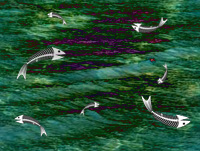Dead in the Water!
 Vancouver, Canada - Aquatic dead zones - stretches of water where little or nothing can survive - were once rare phenomena. Now they are commonplace and eco-systems upon which marine life and humanity in general depend on are being destroyed according to a new study in the journal Science, entitled "Suffocating the Oceans.
Vancouver, Canada - Aquatic dead zones - stretches of water where little or nothing can survive - were once rare phenomena. Now they are commonplace and eco-systems upon which marine life and humanity in general depend on are being destroyed according to a new study in the journal Science, entitled "Suffocating the Oceans.According to Rutger Rosenberg from the University of Gothenburg in Sweden and Robert Diaz from the Virginia Institute of Marine Science, College of William and Mary in the US, dead zones have increased to such an extent that they are now considered to be the key stressor on marine ecosystems’ and rank with over-fishing, habitat loss, and harmful algal blooms as global environmental problems. More than 400 such areas covering a total ocean area of 95,000 square miles were identified last year.
Dead zones are areas that suffer from hypoxia, i.e. lack of oxygen, which scientists believe is caused by agricultural nutrients such as nitrogen and phosphorus that wash off the land and fertilize huge blooms of algae. When dead, the algae are eaten by bacteria, which absorb oxygen from the water as the algae decompose. Hypoxia can drive away tens of thousands of marine animals and, in severe cases, kill them. The expanding agricultural use of new fertilizers and other growth stimulants is simply feeding the dead in the water.
Sewage, animal wastes and atmospheric deposition from the burning of fossil fuels, also contribute to oxygen depletion in the water.
Robert Diaz stated in a Globe and Mail article that In Canada, oxygen depletion in the lower St. Lawrence Estuary is killing cod and other fish species. According to Inka Milewski, a marine biologist with the Conservation Council of New Brunswick also quoted in the Globe and mail article, in New Brunswick, dead zones resulting from nitrogen runoff from fish farms have caused massive fish kills and the transformation of complex and diverse coastal habitat into barren seascapes dominated by a few species. Nearly every summer, the bottom waters of Lake Erie’s central and western basins lose so much oxygen that fish can’t survive.
A major report released earlier this year by the United Nations Environment Programme (UNEP) - "In Dead Water" - notes the number of dead zones are increasing. Given their association with pollutants from urban and agricultural sources, together with the projected growth in coastal development, their numbers may multiply in a few decades, unless substantial changes in policy are implemented.

While the primary culprit creating dead zones in the marine environment is nitrogen from agriculture, the other major contributor is the consumption of fossil fuels. Burning gasoline and diesel creates smog-forming nitrogen oxides, which subsequently clear when rain washes the nitrogen out of the sky and, ultimately, into the ocean.
Technological improvements, such as electric or hydrogen cars, could help solve that problem but the agricultural question is trickier. "Nitrogen is very slippery; it’s very difficult to keep it on land," Diaz notes in a Scientific American article. "We need to find a technology to keep nitrogen from leaving the soil."
Biotechnologies, such as the nitrogen use efficiency (NUE) improvements, may allow farmers to reduce the overall amount of nitrogen they require. Arcadia Biosciences, a California-based company that pursues agriculture-based business opportunities that improve the environment and human health, has been engineering crops to absorb more nitrogen.
"It’s a big economic benefit for farmers if they use only half as much nitrogen as well a big beneficial impact on nitrogen runoff into waterways," Arcadia president and CEO, Eric Rey in the same article. Rey hopes that this product will be adopted as quickly as herbicide-resistant crops, which only took five years from introduction in 1998 to become nearly 70 percent of the corn grown in the U.S., and is now nearly 90 percent. "A reasonable expectation is that there would be a dramatic reduction, maybe by 2018."
While these technologies will not solve the dead water zone problem anytime soon, they do offer grounds for hope. This problem took years to develop and it will take even longer before there is any dramatic turnaround given the current pace of urban growth in coastal regions, and the necessary expansion of agricultural production needed to feed a growing world population.
Some hypoxic ecosystems have improved in recent years due to better management of pollutants. Dead zones in New York’s Hudson River and East River, for example, have actually disappeared. But on a global scale only 4 percent of the dead zones are recovering, according to the Science report.
While it may be unrealistic to try to return to pre-industrial levels of agricultural nutrients flowing into coastal waters, policy makers should seek ways to reduce pollution levels to those seen in the middle of the 20th century, before the dead zones began spreading, note the reports authors.
More information on climate change impacts on the world’s oceans is available in the UNEP Report.
You can return to the main Market News page, or press the Back button on your browser.

